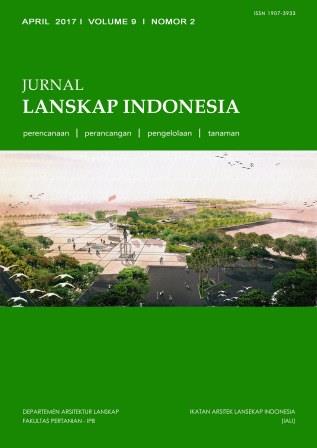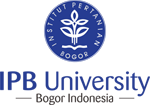PEMANFAATAN CITRA LANDSAT 8 UNTUK ANALISIS INDEKS VEGETASI DI DKI JAKARTA
Abstract
In Article 28 of Law No. 26 Year 2007 on Spatial Planning, plan of providing and utilization of green open space are included in the spatial planning aspects of the city, where the extent of at least 30% of the area of a city. Jakarta which has a total land area of 66.233 hektare achieve, there are currently only 14,94% of the total extent of which is open space. In support of green open space program, it would require the calculation of the land area of green space appropriately, so that the remote sensing data are increasingly being used to measure green open space. This article presents a study on the utilization of Landsat 8 to analyze the vegetation index using the Normalized Difference Vegetation Index (NDVI). NDVI employs the Multi-Spectral Remote Sensing data technique to find vegetation index, land cover classification, vegetation, water bodies, open area, scrub area, hilly areas, agricultural area, thick forest, thin forest with few band combinations of the remote sensed data. Remote sensing, especially Landsat 8 and geographic information systems (GIS) are used to obtain information about the appearance on the earth surface. From the empirical study, the class of sparse vegetation ranged from 0.1795–0.3172 (37.29% of vegetation area; 12,03% of Jakarta area), the class of medium vegetation ranged from 0.3173–0.4110 (25.36% of vegetation area; 8,18% og Jakarta area), and class of heavy vegetation ranged from 0.4111–0.7086 (37.35% of vegetation area; 12,05% of Jakarta area). The rest of the area instead of vegetation about 67,4% of Jakarta area.
Keywords: geographic information systems (GIS), green open space, Jakarta, Landsat 8, NDVI
Downloads
References
Anonim. 2015. Normalize Difference Vegetation Index (NDVI). https://geomusa.com/2015/09/ndvi-normalize-difference-vegetation-index/ (diakses 22 Desember 2016).
Carpenter PL, Walker TD, Lanphear FO. 1975. Plants in The Landscape. San Fransisco: W.H. Freeman Co.
Choi HA, Lee WK, Byun WH. 2012. Determining the effect of green spaces on urban heat distribution using satellite imagery. Asian Journal of Atmospheric Environment 6(2):127-135.
Dwihatmojo, R. 2010. Ruang terbuka hijau yang semakin terpinggirkan. http://www.bakosurtanal.go.id/artikel/show/ruang-terbuka-hijau-yang-semakin-terpinggirkan (diakses 11 Februari 2017).
Fandeli C, Kaharudin, Mukhlison. 2004. Perhutanan Kota. Yogyakarta: Fakultas Kehutanan Universitas Gadjah Mada.
Hashimoto H, Natuhara Y, Morimoto Y. 2005. A habitat model for Parusmajor minor using a logistic regression model for the urban area of Osaka, Japan. Landscape and Urban Planning 70 (3-4): 245-250.
Hung, T. 2000. MODIS Application in Monitoring Surface Parameters. Institute of Industrial Science. Tokyo: University of Tokyo.
Jaya, INS. 2014. Analisis Citra Digital. Bogor: IPB Press.
Lillesand TM, Kiefer RW. 1997. Penginderaan Jauh dan Interpretasi Citra. Yogyakarta: Gadjah Mada University Press.
Martiyanti, E. 2016. RTH di DKI capai 9.896,8 Hektare. http://www.jakarta.go.id/v2/ news/2016/10/rth-di-dki-capai-9.8968-hektare#.WKKSx2997Dc (diakses 22 Desember 2016).
Nurbaya, A. 2015. Distribusi Tipologi Kepemilikan RTH DKI Jakarta Menggunakan Teknik Remote Sensing Citra Satelit Resolusi Tinggi [Tesis]. Bogor: Institut Pertanian Bogor.
Segah, H. 1999. Kajian akurasi citra Landsat-TM yang didukung citra NOAA-AVHRR dalam mendeteksi perubahan penutupan lahan areal proyek pengembangan lahan gamhut (PLG) sejuta hektar di Propinsi
Kalimantan Tengah [Tesis]. Bogor (ID): Institut Pertanian Bogor.
Sudaryanto, Rini MS. 2014. Penentuan ruang terbuka hijau (rth) dengan index vegetasi NDVI berbasis citra Alos Avnir-2 dan sistem informasi geografi di Kota Yogyakarta dan sekitarnya. Magistra 89 (26): 90–96.
Martiyanti, E. 2016. RTH di DKI Capai 9.896,8 hektare. http://www.jakarta.go.id/v2/ news/2016/10/rth-di-dki-capai-9.8968-hektare#.WJ8r1G997Dc (diakses 11 Februari 2017).
Purwanto, A. 2015. Pemanfaatan citra Landsat 8 untuk identifikasi Normalized Difference Vegetation Index (NDVI) di kecamatan silat hilir kabupaten Kapuas Hulu. Jurnal Edukasi 13 (1): 2 –36.
Undang-Undang RI No. 26 Tahun 2007 tentang tentang Penataan Ruang.
Wulandari LD, Rachmawati TA, Ramdlani S. 2013. Hirarki peran ragam ruang terbuka hijau (rth) dalam peningkatan kualitas ekologis lingkungan pusat Kota Malang [Laporan Akhir PUPT]. Malang: Universitas Brawijaya.
Zain AFM, Permatasari PA, Ainya CN, Destriana N, Mulyati DF, Edi S. 2015. Monitoring The detection of urban open space at Jakarta, Bogor, Depok, and Tangerang–Indonesia by using remote sensing technique for urban ecology analysis. Procedia Environmental Sciences 24:87–94.
This journal permits and encourages authors to post items submitted to the journal on personal websites or institutional repositories both prior to and after publication, while providing bibliographic details that credit, if applicable, its publication in this journal. However, after the article is submitted and published in this journal, it is fully copyrighted by the Jurnal Lanskap Indonesia or JLI. If excerpts from other copyrighted works are included, the author must obtain written permission from the copyright owner and give credit to the source in the article. Then, the writer or reader is allowed to copy, share, and redistribute articles/material in any form. But it must still include the appropriate source and credit because the article in this journal is licensed by Creative Commons Attribution 4.0 International License (CC BY 4.0).
I. Proposed Policy for Journals That Offer Open Access
Authors who publish with this journal agree to the following terms:
- Authors retain copyright and grant the journal right of first publication with the work simultaneously licensed under a Creative Commons Attribution License that allows others to share the work with an acknowledgement of the work's authorship and initial publication in this journal.
- Authors are able to enter into separate, additional contractual arrangements for the non-exclusive distribution of the journal's published version of the work (e.g., post it to an institutional repository or publish it in a book), with an acknowledgement of its initial publication in this journal.
- Authors are permitted and encouraged to post their work online (e.g., in institutional repositories or on their website) prior to and during the submission process, as it can lead to productive exchanges, as well as earlier and greater citation of published work (See The Effect of Open Access).
II. Proposed Policy for Journals That Offer Delayed Open Access
Authors who publish with this journal agree to the following terms:
- Authors retain copyright and grant the journal right of first publication, with the work after publication simultaneously licensed under a Creative Commons Attribution License that allows others to share the work with an acknowledgement of the work's authorship and initial publication in this journal.
- Authors are able to enter into separate, additional contractual arrangements for the non-exclusive distribution of the journal's published version of the work (e.g., post it to an institutional repository or publish it in a book), with an acknowledgement of its initial publication in this journal.
- Authors are permitted and encouraged to post their work online (e.g., in institutional repositories or on their website) prior to and during the submission process, as it can lead to productive exchanges, as well as earlier and greater citation of published work (See The Effect of Open Access).



























